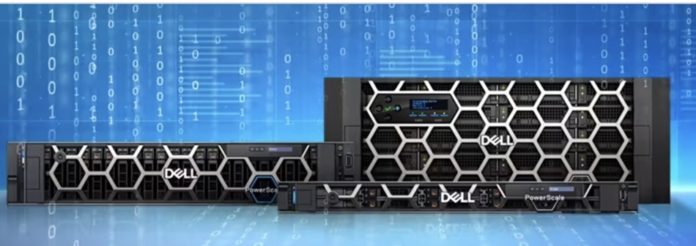OneFS 9.5, the latest PowerScale OS version, provides a claimed 55 percent in streaming data access speed plus cyber resiliency improvements.
PowerScale and the prior Isilon scale-out filers are powered by OneFS and come in all-flash and hybrid flash-disk formats.

Dell’s director of product management Chris Mount told us: “There is a 55 percent increase in streaming read performance on F600 and F900 platforms. That means our our F601 all-flash node can get to line rate on 100 Gig networking at the front end.” That’s from a 1RU box and it’s entirely from software changes and comparing OneFS 9.4 to the latest version using NVMe SSDs.
It’s been achieved by rebuilding the caching process for NVMe drives with lots of optimizations, such as side-stepping the L2 cache. Mount said there is more performance to come. That means PowerScale will have a stronger enterprise HPC story.
He said that the PowerScale team is convinced that hybrid flash-disk systems are worthwhile in terms of affordable and storage performance and capacity and: “More seamless tiering is coming” and “We think the hard disk drive is here to stay for quite a while.”
There are a mass of other improvements. For example a Dell blog says: “Enhancements to SmartPools in OneFS 9.5 introduce configurable transfer limits. These limits include maximum capacity thresholds, expressed as a percentage, above which SmartPools will not attempt to move files to a particular tier, boosting both reliability and tiering performance.”
“Granular cluster performance control is enabled with the debut of PowerScale SmartQoS, which allows admins to configure limits on the maximum number of protocol operations that NFS, S3, SMB, or mixed protocol workloads can consume.”
The PowerScalers are also working to improve the system’s performance per watt efficiency – dramatically – and capacity per rack unit. They think that performance and capacity efficiency are both going to be important customer concerns.
Cyber resiliency is another major concern and Dell has added a software firewall inside a PowerScale OneFS cluster. It’s a zero trust thing, with the assumption that malware actors could break through a datacenter’s firewall infrastructure and then have access to the PowerScale array. So they have a separate firewall inside the firewall area to cope with – a Russian Doll-like security concept.
This is based on a partnership with Superna and API-level access to put immutable snapshots behind a so-called smart air-gap. If cluster telemetry shows bad actors are trying to access the cluster then network access to the air-gapped snapshots is closed down.
OneFS now supports self-encrypting 15TB and 30TB SSDs as well.
The roadmap for OneFS includes a stronger public cloud presence. Mount said Project Alpine for PowerScale is coming soon. That means OneFS being ported to the three main public clouds – AWS, Azure and GCP – though not necessarily all at once. Think about the idea of a OneFS data fabric proving a single environment covering the on-premises and multi-public cloud worlds.
Dell is also building partnerships between data virtualizers such as Dremio and Databricks so that they can use PowerScale storage as a platform for the data they are holding. It thinks that the unstructured data market is becoming heavily verticalized and partnerships open access into different vertical markets.
We should expect to hear more about this and the OneFS Alpine project progress later this year. We hear initial customers testing this are super-excited. The takeaway is that the PowerScale system story is getting stronger and there’s more to come. And that includes the portable PowerScale controller upgrades to Sapphire Rapids processors.
The new OneFS 9.5 code is available on the Dell Technologies Support site, as both an upgrade and reimage file, allowing both installation and upgrade of this new release.








